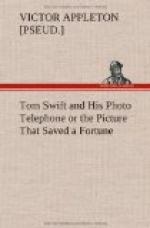“Yes, Dad, it has been done, in a way!” he said, earnestly. “No one has sent a picture over a telephone wire, as far as I know, but during the recent hydroplane tests at Monte Carlo, photographs taken of some of the events in the morning, and afternoon, were developed in the evening, and transmitted over five hundred miles of wire to Paris, and those same photographs were published in the Paris newspapers the next morning.”
“Is that right, Tom?”
“It certainly is. The photographs weren’t so very clear, but you could make out what they were. Of course that is a different system than the one I’m thinking of. In that case they took a photograph, and made a copper plate of it, as they would for a half-tone illustration. This gave them a picture with ridges and depressions in copper, little hills and valleys, so to speak, according to whether there were light or dark tints in the picture. The dark places meant that the copper lines stood up higher there than where there were light colors.”
“Now, by putting this copper plate on a wooden drum, and revolving this drum, with an electrical needle pressing lightly on the ridges of copper, they got a varying degree of electrical current. Where the needle touched a high place in the copper plate the contact was good, and there was a strong current. When the needle got to a light place in the copper—a depression, so to speak—the contact was not so good, and there was only a weak current.”
“At the receiving end of the apparatus there was a sensitized film placed on a similar wooden drum. This was to receive the image that came over the five hundred miles of wire. Now then, as the electrical needle, moving across the copper plate, made electrical contacts of different degrees of strength, it worked a delicate galvanometer on the receiving end. The galvanometer caused a beam of light to vary—to grow brighter or dimmer, according as the electrical current was stronger or weaker. And this light, falling on the sensitive plate, made a picture, just like the one on the copper plate in Monte Carlo.”
“In other words, where the copper plate was black, showing that considerable printing ink was needed, the negative on the other end was made light. Then when that negative was printed it would come out black, because more light comes through the light places on a photograph negative than through the dark places. And so, with the galvanometer making light flashes on the sensitive plate, the galvanometer being governed by the electrical contacts five hundred miles away, they transmitted a photograph by wire.”
“But not a telephone wire, Tom.”
“That doesn’t make any difference, Dad. It was a wire just the same. But I’m not going into that just now, though later I may want to send photographs by wire. What I’m aiming at is to make an apparatus so that when you go into a telephone booth to talk to a friend, you can see him and he can see you, on a specially prepared plate that will be attached to the telephone.”




